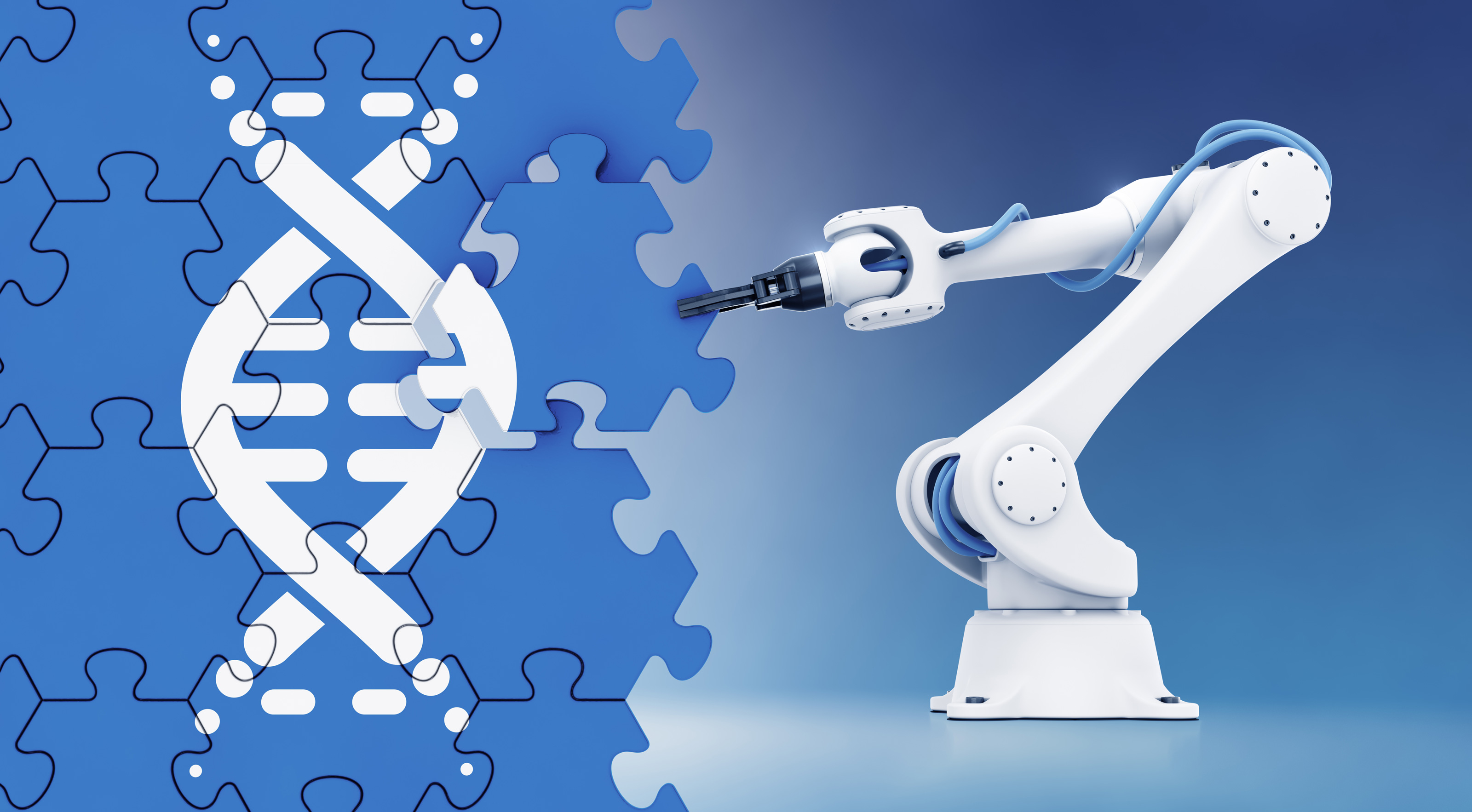Feature
Robotics: transforming cell and gene therapy manufacturing
Several companies are developing robotics to automate cell and gene therapy manufacturing, but some challenges persist, Sally Turner writes.

Robotic arm assembling a wall of jigsaw puzzle with a pictogram of DNA molecule pictured on it. Credit: Getty Images/ Artystarty
In recent years, cell therapies have resulted in the successful treatment of conditions ranging from lymphoid cancers to fistulas associated with Crohn’s disease. With several recent advances, additional therapeutics with strong clinical profiles are set to fruther transform treatment for patients.
Given the highly complex and labour-intensive nature of cell and gene therapy (CGT) manufacturing, several groups have developed approaches to automate parts of the process, sometimes integrating robotics into workflows for steps like liquid handling.
Although a robotics-focused approach is promising, experts say piecemeal retrofitting of different technologies into existing processes is unlikely to be as efficient as end-to-end automation. It is also likely to introduce new variables into highly regulated processes.
“However, setting up automation capabilities for biomanufacturing requires significant initial funding and collaboration with solution providers,” says Vandana Iyer, principal at industry research and analysis consultancy Frost & Sullivan, “which is not feasible for all biomanufacturing companies due to budget constraints.”
The biomanufacturing industry needs vendors that specialise in automation to drive innovation in technology standards across the pharma sector to support the growing need. Besides evolving manufacturing processes, this is one key contributing reason why not much success had occurred in this space, explains Sanjay Srivastava, managing director, cell and gene therapy lead at data and analytics consultancy Accenture. “The industry has investment opportunities, but is still lacking the key standards to develop automation technology that would allow large scale development efficiently.”
Advances in robotics
Two new versions of end-to-end (E2E) robotic systems have emerged in the past few years: proprietary robotics systems and operations-agnostic robotic systems. Proprietary robotics systems can be defined as bespoke machines that creates an E2E closed-loop system integrating adaptable, yet proprietary unit operations. Alternatively, operations-agnostic systems are E2E systems that connect separate, multi-vendor automated unit operation systems. Currently, most CGT manufacturers use disconnected single-step or multi-step automation solutions to carry out manufacturing processes such as cell washing or virus purification.
“These machines reduce the variability of manual processing, but large labour costs remaindue to the need of human operators to move product, monitor machines, and collate multiple machines’ data,” says Srivastava. “Manufacturers are looking to move towards fully E2E automated, data integrated and agile systems to increase capacity, and improve batch variability. As a response, the market is moving towards robotic solutions [which]provide not only automated processes, but also intelligent services depending on process results and data.”
The ‘Cell Shuttle’
Cellares, one of the industry innovators in this sphere, has recently developed ‘Cell Shuttle’ – technology using fully closed, E2E manufacturing. The aim is to provide the flexibility needed in early development and the standardisation required to commercially scale up these therapies and meet patient demand.
The company intends to significantly reduce manufacturing costs “by approximately 50%” and provide sufficient capacity to meet global demand.
“Both of these bottlenecks arise from the complexity to manufacture these therapies with manual or semi-automated processes,” says John Tomtishen, vice-president of Operations at Cellares. “[These] require a highly-skilled workforce drawn from a small labour pool operating in large clean room facilities. The Cell Shuttle will address the root cause of these challenges through its ability to leverage robotics in a fully closed, walk-away, E2E automation platform that eliminates the need for manual intervention, in small, enclosed units that can produce 16 therapeutics at a time.”
Cellares’ competitors include Ori Biotech, which offers a flexible platform that closes, automates, and standardises manufacturing for therapeutics developers. Multiply Labs also builds cloud-controlled robotic devices that produce customised medications.
Future of cell and gene therapy manufacturing
As the major cell therapy manufacturers have already invested decisively in production, they may be slow to relinquish their existing processes. However, E2E automation through technology platforms such as Cell Shuttle and similar innovations will likely play an increasing role moving forward. The technology will help address bottlenecks associated with scaling these therapies, reducing manufacturing costs, and ensuring patient access.
Chemistry, manufacturing, and controls (CMC) is crucial to cell and gene therapy development and actioning a CMC standard for workflows will improve safety and efficiency.
Big pharma companies are adopting digitisation to monitor factory automation in real-time, enabling them to save on their finances and processes. Digital twin models of factories are assisting biomanufacturing companies to ‘virtually’ plan how the factory operations will take place. This is helping them to predict modifications and assessment of an efficient workflow, says Iyer.
“Higher adoption of digital supply chain will ensure there is no gap in the entire value chain, allowing timely delivery of therapeutics and prevent drug counterfeiting,” Iyer predicts. “A more robust system for two very important categories—vaccine delivery and CGT—will be in place to track and trace everything, from raw material sourcing to therapy delivery.”
Chemistry, manufacturing, and controls (CMC) is crucial to cell and gene therapy development and actioning a CMC standard for workflows will improve safety and efficiency.
“While, technically, CGT manufacturing at site of care will be feasible, industry will need to overcome operational and regulatory hurdles to make such a model viable for commercially available therapies,” observes Srivastava. “Emerging robotics technologies are not far off in the future (three to five years) and are becoming a reality at breakneck speed. With technology advancing, getting standardised, and patient volume increasing, we believe a decentralised operating model is conceivable.”
Ultimately, automation and robotics may encourage further innovations in CGT development by freeing up a skilled workforce to focus on research and development instead of costly and time-consuming manual processing. That can only be good news for patients awaiting essential treatments.